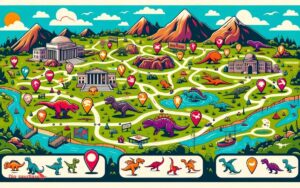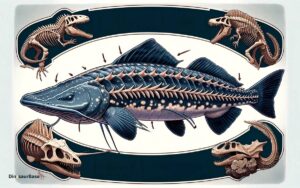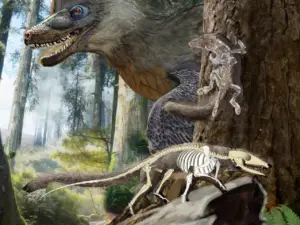What Animal Is a Direct Descendant of Dinosaurs
Nearly 10,000 species of birds grace our planet today, each a direct descendant of the mighty dinosaurs that once dominated the Earth. This evolutionary link bridges a gap millions of years wide, offering a fascinating glimpse into how creatures of the air evolved from the giants of the past.
The transition from scales to feathers marks one of the most significant transformations in the animal kingdom, with the Archaeopteryx fossil providing compelling evidence of this shift. As one explores the unique traits that avian dinosaurs and their modern counterparts share, it becomes clear that the legacy of dinosaurs is far from extinct.
This insight not only challenges our understanding of evolution but also invites us to look at our feathered friends in a new light, pondering on what other secrets they might hold.
Key Takeaways
- Birds are the direct descendants of theropod dinosaurs.
- Archaeopteryx serves as a crucial transitional fossil linking dinosaurs and modern birds.
- Genetic evidence confirms birds share common ancestors with theropod dinosaurs.
- Avian diversity today reflects the evolutionary journey from dinosaurs.
The Evolutionary Link
One can't overlook the compelling evidence that birds, as we observe them today, are the direct descendants of theropod dinosaurs, a lineage that meticulously documents the transition from reptilian to avian characteristics through the fossil record.
This evolutionary link showcases a series of gradual modifications over millions of years, where structural and functional changes in theropods paved the way for the emergence of birds. Notably, the discovery of fossils with preserved feathers, a trait once thought exclusive to birds, has been pivotal. These findings illustrate the shared ancestry, highlighting the presence of feathers in non-avian theropods.
Furthermore, skeletal similarities, such as hollow bones and specific adaptations in the wrist and shoulders, underscore the evolutionary continuity. This evidence collectively forms a robust framework supporting the descent of birds from theropod dinosaurs.
Birds: Living Dinosaurs
Building on the established evolutionary link, it's evident that modern birds aren't mere descendants of theropod dinosaurs but are, in fact, living dinosaurs themselves, showcasing a direct lineage that has thrived through the ages. This assertion is supported by rigorous phylogenetic analysis, which places birds within the Theropoda group, a suborder of dinosaurs that includes the formidable Tyrannosaurus rex.
The transition from dinosaurs to birds represents one of the most significant evolutionary transformations, illustrating a remarkable journey of adaptation and survival. Birds retain several key anatomical and physiological traits inherited from their dinosaur ancestors, such as a similar skeletal structure, which further cements their status as direct descendants. This continuity underscores the dynamic nature of evolution, revealing the persistence of ancient lineages into the modern era.
From Scales to Feathers
The evolution from scales to feathers marks a pivotal chapter in the story of avian ancestors, revealing a complex interplay of genetic and environmental factors that facilitated this transformative adaptation. This evolutionary leap wasn't abrupt but gradual, underscoring the nuanced nature of biological change.
Researchers have elucidated several key aspects of this transition:
- Genetic mutations allowed for the differentiation of scales into proto-feathers, suggesting an inherent genetic predisposition towards feather development.
- Environmental pressures, such as the need for thermoregulation and mating displays, drove the selection for feathers.
- Structural modifications in skin appendages enabled the emergence of various feather types, each serving different functions.
- Biochemical pathways were repurposed from scale production to feather formation, illustrating an elegant example of evolutionary resourcefulness.
These elements collectively paint a picture of evolution as a dynamic, adaptive process, paving the path from scaly dinosaurs to our feathered birds.
Archaeopteryx: The Transitional Fossil
Bridging the gap between prehistoric dinosaurs and modern birds, Archaeopteryx stands as a crucial transitional fossil, shedding light on the evolutionary journey from scales to feathers. Discovered in the 19th century in Germany's Solnhofen limestone quarries, it possesses both avian and reptilian characteristics, making it an exceptional case study for paleontologists and evolutionary biologists.
Archaeopteryx's anatomy reveals a blend of features: it had wings with flight feathers, similar to modern birds, yet retained jaws with sharp teeth and a long, bony tail, akin to dinosaurs. This unique combination underscores its role as a key intermediary form, supporting the theory that today's birds are directly descended from theropod dinosaurs.
Analyzing Archaeopteryx's fossils, scientists gain invaluable insights into the complex process of evolutionary transformation, marking a significant milestone in the understanding of life's history on Earth.
Avian Dinosaurs' Unique Traits
Avian dinosaurs exhibit a suite of unique traits that underscore their evolutionary divergence from their ancient counterparts.
The evolution and multifunctionality of feathers not only facilitated thermal regulation but also played a pivotal role in the mechanics of flight.
Additionally, the adaptation of hollow bones and diverse beak structures further optimized these creatures for aerial efficiency and ecological versatility.
Feather Evolution and Function
Feathers, having evolved from the scales of their reptilian ancestors, serve a multitude of functions in avian dinosaurs, from facilitating flight to thermal regulation. This evolutionary adaptation has enabled birds to thrive in a variety of environments, showcasing the versatility and innovation of nature. Feathers aren't merely for adornment; they play crucial roles in the survival and efficiency of these creatures.
- Insulation: Feathers trap air close to the body, providing an insulating layer that maintains body temperature.
- Camouflage: Various feather patterns and colors help birds blend into their surroundings, evading predators or sneaking up on prey.
- Communication: Brightly colored feathers can be used to attract mates or intimidate rivals.
- Waterproofing: Oil from preen glands coats feathers, repelling water and maintaining buoyancy.
Hollow Bones, Enhanced Flight
While the evolution of feathers marked a significant adaptation for thermal regulation and flight, the development of hollow bones in avian dinosaurs represented another critical evolutionary stride, enhancing their flight capabilities and overall agility. This adaptation, pivotal for the ascendancy of avian species, allowed these creatures to achieve remarkable feats of flight.
The structural design of hollow bones, balancing strength and lightness, exemplifies evolutionary innovation. These bones, fortified internally by a crisscrossing network of struts, or trabeculae, provide the necessary support for flight without the weight penalty of solid bones.
This intricate balance of lightweight yet sturdy skeletal architecture enabled avian dinosaurs to evolve into the diverse array of flying birds we observe today, showcasing a remarkable example of evolutionary ingenuity and adaptation.
Beak Diversity and Adaptation
The diversity and adaptation of beaks among descendants of dinosaurs, now known as birds, stand as a testament to their evolutionary success, showcasing a broad range of functions from feeding to mating displays.
- *Hummingbirds possess long, slender beaks, perfectly shaped for accessing nectar within flowers, illustrating a fine-tuned adaptation for their feeding strategy.*
- *Woodpeckers have strong, chisel-like beaks, enabling them to bore into wood to find insects, a clear example of adaptation to a specific feeding niche.*
- *Pelicans feature a large beak with a unique pouch, used for scooping fish out of water, showcasing adaptation for their piscivorous lifestyle.*
- *The elaborate and colorful beaks of some bird species, such as toucans, play a crucial role in mating displays and territory defense, indicating that beak evolution is also driven by social and reproductive needs.*
The Great Dinosaur-Bird Split
Understanding the evolutionary divergence that led to the descendants of dinosaurs evolving into birds requires a thorough examination of anatomical and genetic evidence. This pivotal moment, often termed the great dinosaur-bird split, underscores a significant evolutionary shift during the late Jurassic period. Researchers analyze fossil records, noting specific adaptations like the development of feathers, a lighter skeletal structure, and changes in limb proportions, which suggest a gradual transition from terrestrial to avian lifestyles.
Genetic studies further support this transition, indicating shared DNA sequences between modern birds and certain theropod dinosaurs. These pieces of evidence collectively point towards a complex evolutionary pathway, marked by incremental changes over millions of years, leading to the diverse avian species we observe today. This analysis underscores the intricate processes driving the emergence of birds from their dinosaurian ancestors.
Modern Birds and Their Ancestors
Modern birds, descendants of a long lineage tracing back to dinosaurs, exhibit a fascinating example of evolutionary transformation. The discovery of Archaeopteryx, with its blend of avian and dinosaurian features, provides crucial evidence of this lineage, bridging gaps in our understanding of avian evolution.
This lineage's complexity is further highlighted by the vast diversity seen in modern avian species, suggesting a rich evolutionary history influenced by varied ecological niches.
Birds: Evolving From Dinosaurs
Birds, as the direct descendants of theropod dinosaurs, represent a fascinating evolutionary transition from ancient reptiles to the diverse avian species we observe today. This lineage showcases a remarkable journey from creatures once bound to the earth, to entities that conquer the skies. The evidence supporting birds' dinosaurian heritage is both compelling and multifaceted, providing a clear narrative of evolutionary transformation.
- Feathered Fossils: Discoveries of feathered non-avian dinosaurs bridge morphological gaps.
- Skeletal Similarities: Shared features like hollow bones and three-toed limbs underscore common ancestry.
- Egg-Laying Habits: Both groups share distinctive reproductive traits, including eggshell composition.
- Genetic Markers: Modern research in DNA sequencing reveals genetic continuities between birds and their dinosaur ancestors.
Thus, birds embody a living link to a prehistoric past, illustrating the dynamic nature of evolutionary processes.
Archaeopteryx: Evolutionary Link
Building on the evidence of birds' dinosaurian heritage, the discovery of Archaeopteryx offers a critical perspective on how ancient avians bridged the gap between their dinosaur ancestors and contemporary bird species. Fossil records indicate that Archaeopteryx possessed features characteristic of both dinosaurs and birds, such as feathers, a wishbone, and a three-toed limb structure, paralleling modern birds.
Yet, it also retained distinctly dinosaurian traits, including teeth and a long, bony tail. This amalgamation of characteristics underscores Archaeopteryx's pivotal role in the evolutionary narrative, embodying the transitional phase from terrestrial dinosaurs to the avian lineage. Scholars suggest that its unique anatomy reflects adaptive responses to environmental pressures, facilitating the evolutionary trajectory towards flight capabilities and establishing a lineage that would culminate in the diverse bird species observed today.
Modern Avian Diversity
Exploring the vast tapestry of avian diversity reveals how descendants of dinosaurs have evolved into the myriad bird species we observe today, each adapted to its ecological niche with remarkable precision. Modern birds, or Aves, showcase a spectacular array of forms, functions, and behaviors that highlight their evolutionary success.
- Hummingbirds: Representing the pinnacle of aerial maneuverability, their ability to hover stems from a unique wing structure, an evolutionary marvel.
- Raptors: With keen eyesight and powerful talons, raptors epitomize the predatory prowess inherited from their theropod ancestors.
- Penguins: Adapted for life in aquatic environments, their flipper-like wings and streamlined bodies demonstrate significant evolutionary shifts from flight to swimming.
- Songbirds: Exhibiting complex vocalizations, songbirds underscore the evolutionary significance of communication in social structures and mating rituals.
These examples underscore the dynamic evolutionary pathways that have led from dinosaurs to the birds we know today.
Genetic Evidence of Descent
Analyzing genetic markers has revealed compelling evidence that modern birds are direct descendants of dinosaurs. This analysis involves comparing sequences of DNA from various species of birds and extinct dinosaurs, particularly theropods, which are closely related to modern birds.
Scientists have identified several genetic sequences that are common between these groups, suggesting a direct lineage. Moreover, specific genes responsible for the development of feathers, a characteristic feature of birds, have been traced back to theropods. This genetic continuity underscores the evolutionary transition from dinosaurs to birds, reinforcing the hypothesis that birds didn't simply evolve from dinosaurs but are, in essence, living dinosaurs.
This genetic evidence provides a robust framework for understanding the evolutionary processes that have shaped the diversity of life on Earth, offering a clear link between the ancient and the modern.
The Role of Extinction Events
Extinction events have played a pivotal role in shaping the evolutionary journey of birds from their dinosaur ancestors, acting as both a catalyst for diversification and a filter for survival. These pivotal moments in Earth's history have drastically altered the course of evolutionary pressure, leading to a significant impact on the lineage of dinosaurs transitioning into birds.
To understand this transformation, consider the following factors:
- Mass extinction events eliminated numerous competing species, reducing ecological competition.
- Climate changes forced adaptations in behaviors, physiology, and habitats.
- Survival of smaller, adaptable species favored traits that are predominant in modern birds.
- Geographic isolation after events led to varied evolutionary paths, contributing to the diversity of species.
These elements underscore the profound influence of extinction events on the evolution of birds from their dinosaur predecessors.
Preserving the Dinosaur Legacy
The preservation of the dinosaur legacy has become a critical arena in paleontology, focusing on the meticulous study and conservation of fossils to understand the evolutionary bridge between ancient reptiles and modern birds.
This endeavor employs cutting-edge techniques, ranging from three-dimensional scanning to molecular analysis, to unravel the complexities of dinosaur biology and their ecological niches. Scholars meticulously examine fossilized remains to decipher the morphological transformations that illustrate the lineage from dinosaurs to avians.
Preserving these relics not only enriches our understanding of Earth's geological past but also illuminates the mechanisms of evolution and adaptation. Through such rigorous scientific pursuits, the legacy of dinosaurs endures, offering invaluable insights into the resilience and diversity of life on our planet.
Conclusion
In conclusion, birds, the vibrant vestiges of vanished vertebrates, vividly validate their lineage as direct descendants of dinosaurs. Through the lens of evolutionary biology, the transformation from scales to feathers, underscored by the iconic Archaeopteryx, unveils a vivid story of survival and adaptation.
Genetic evidence galvanizes this link, illustrating an unbroken chain of life through the ages. As avian species soar in the skies, they preserve the profound legacy of their prehistoric predecessors, encapsulating eons of evolution in every flap of their feathers.





